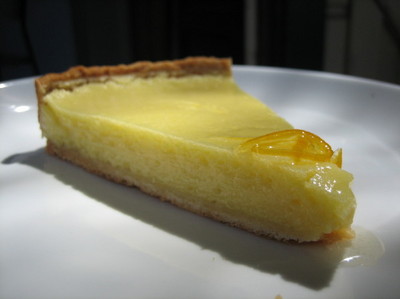Lemon curd tart
While living in San Francisco, training as a chef at Tante Marie’s Cooking School, I went through a phase of making lemon tarts. At home we ate them day after day after day, as I had to practise making the perfect sweet ‘shortcrust’ tart dough and the perfect lemon curd. Matt didn’t seem to mind.
 Both crust and curd are harder than you might think. The tart shell must be perfectly even and crisp; the curd must have a perfect balance of sweet and sour, and be luxuriously rich and smooth. And then there is the challenge of slowly baking the assembled tart such that the curd sets up beautifully and does not curdle, blister or crack.
Both crust and curd are harder than you might think. The tart shell must be perfectly even and crisp; the curd must have a perfect balance of sweet and sour, and be luxuriously rich and smooth. And then there is the challenge of slowly baking the assembled tart such that the curd sets up beautifully and does not curdle, blister or crack.
 In San Francisco I used Meyer lemons – a particularly sweet and fragrant variety – but now back in London they are nowhere to be found. I recently dug out my notes (including tips I gleaned from two fantastic pastry chefs, Jennifer Altman and Jim Dodge) to make lemon tarts for one of my Secret Kitchen dinners. I served it with poached forced Yorkshire rhubarb flavoured with a little orange zest, and thick double cream.
In San Francisco I used Meyer lemons – a particularly sweet and fragrant variety – but now back in London they are nowhere to be found. I recently dug out my notes (including tips I gleaned from two fantastic pastry chefs, Jennifer Altman and Jim Dodge) to make lemon tarts for one of my Secret Kitchen dinners. I served it with poached forced Yorkshire rhubarb flavoured with a little orange zest, and thick double cream.
Note that the dough’s sugar:butter:flour ratio is 1:2:3 – easy to remember. For a wonderfully golden curd, use free range organic eggs.
Recipe: Lemon curd tart.pdf
Makes: one 9”-10” tart, which should serve at least 8 people
For the dough:
120g plain white flour
40g white sugar
a pinch of salt
80g unsalted butter, at cool room temperature, cut into cubes
the scraped seeds of half a vanilla pod (pop the pod in a jar of sugar to make vanilla sugar)
1 large egg, lightly beaten
For the curd:
200g white sugar
4 tbsps grated lemon zest
100ml freshly squeezed lemon juice
3 egg yolks
2 whole eggs
a pinch of salt
85g unsalted butter, at cool room temperature, cut into cubes
- Make dough: Mix flour, sugar and salt. Toss in butter and vanilla seeds and process in a food processor or rub together with fingertips or table knives. Stop when it resembles breadcrumbs. Mix in a dribble of egg – just enough to be able to bring the dough together in a ball. You may or may not need all the egg. (See end of step 3 for how to use leftover egg.) Do not work the dough or it will go tough. Wrap tightly in clingfilm and chill for at least an hour.
- Make curd: Blitz sugar and zest together in a food processor. This releases the fragrant lemon oils into the sugar and ensures zest is finely minced. Put sugar, lemon juice, eggs and salt into a bowl over a pan of barely simmering water and whisk continually while the mixture heats and thickens. This will happen at around 80C (176F). Do not overcook or it will curdle. Remove bowl from heat and let cool to around 60C (140F), whisking occasionally. You can sieve the curd at this point for a smoother result. Using an immersion blender (for which you may need to transfer the curd to a more suitably shaped container), blend in butter cube by cube until all has melted. You should have a smooth, opaque emulsified curd. Taste and blend in a little lemon juice, sugar or salt if needed. Cover with cling film pressed against surface. Chill if not immediately proceeding with recipe.
- Prepare tart shell: Lightly flour work surface and rolling pin and roll dough out to a thickness of 3mm. Rotate dough frequently and use more flour as needed to ensure it does not stick and rolls evenly. Carefully lay into tart tin and press into shape. Trim off excess, allowing it to stick up above the tin’s rim by a couple of mm. Chill for at least an hour. Heat oven to 180C (355F) with a rack in the bottom third. Prick base of tart shell several times with tines of a fork, line with parchment or foil and fill with baking beans. Bake for 30 mins or until evenly golden brown and cooked through. Remove from oven, remove beans and lining, brush with a little beaten egg and return to the oven for a few minutes. This helps seal the base and keep it crunchy. Let shell cool in its tin on a rack.
- Complete tart: Heat oven to 150C (300F) with a rack in the middle. Pour curd into tart shell until a couple of mm below rim. If too thick to pour, heat curd gently above a pan of barely simmering water, whisking. Bake for 20-30 mins or until curd has just set. When nudged, the curd should wobble like a soft jelly but not ripple like a wave. Turn off heat and leave to cool inside oven. Serve slightly chilled. It will keep well in the fridge wrapped in clingfilm for a couple of days.
 Learn more about lemons here…
Learn more about lemons here…

 Follow
Follow
Comments are closed